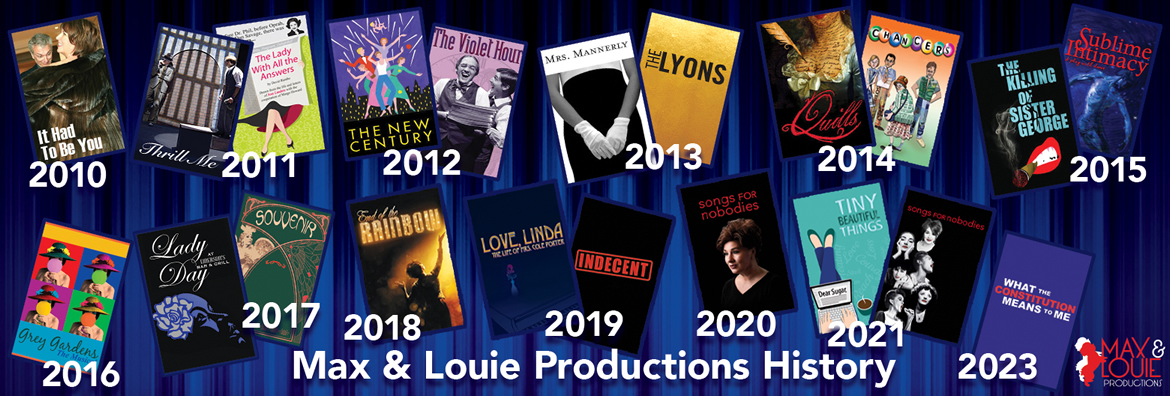The Killing of Sister George
Website Review
Tina Farmer – KDHX, July 15, 2015
‘The Killing of Sister George’ entertains with a twisted tale of love and death
Darkly comic and nearly equally as unsettling, “The Killing of Sister George,” presumably relates the sad story of the death of a beloved radio character. Under this pretense the audience is offered an at times too intimate look at a disturbingly codependent relationship between the actress who portrays Sister George and her roommate. The play, set in the 1960s, was considered daring and explicit, and the movie version garnered an X rating at its release, possibly due to the presumed lesbian relationship as well as the disturbing control struggles, verbal abuse, and suggested violence between the lead characters.
June Buckridge dominates her roommate and lover, Alice “Childie” McNaught, with cutting comments, demands of obeisance and penitence, and a fiercely stubborn will, which turns darker still with the aid of alcohol. She is demanding, unforgiving and surly, finding almost everyone who crosses her path inadequate. Alice, in a semi-repressed state of arrested adolescence, responds with sharp comebacks and vicious maneuverings of her own. Theirs is a volatile relationship, and June’s impending lack of work only amps the tension between the two.
June’s role as the voice of the kind nurse, Sister George, is about to end. Though she’s a favorite character on a popular radio soap opera, its ratings are slipping and June’s questionable public behavior and frequent outbursts have put her character in the crosshairs. The superficially concerned but critical and haughty Mrs. Mercy Croft becomes entangled in the two women’s lives as she updates June on every detail of her character’s death with vicious delight while currying favor with Alice. Clairvoyant neighbor Madame Xenia assists as she can, foreshadowing the play’s events with flamboyant accuracy, and providing both warmth and needed comic relief. Her loyalty and devotion to June may be based solely on a love for the character June portrays; still the soothsayer comes across as the only character that truly cares about June and her well being.
“The Killing of Sister George” is not a light evening of theater, however. Fortunately, the performances are as rich as the story is dark. Lavonne Byers is overtly mannish, abusive without conscience, generally churlish and unlikeable, and yet profoundly compelling as June. Her closing moment is wry, resilient and, at the same time, filled with venomous anger. It is a perfect encapsulation of the character. Shannon Nara is slyly devilish and manipulative as her lover, Alice. She chooses ambition over loyalty and a steely will own that reveals itself scene-by-scene. Erin Kelley is spot-on fashionable, and just as perfectly catty, as the scheming Mercy Croft, and Cooper Shaw’s Madame Xenia flitters and dances across the stage with a lilting, musical sense to her movements and voice.
Director Brooke Edwards neither shies away from nor overemphasizes the cruelty inherent in the women’s relationship or June’s apparent dislike of nearly everyone who crosses her path. The set, by Dunsi Dai, and costumes, by Cyndi Lohrmann, help to remind us of the time; and many of the fashion choices, particularly Mercy Croft’s of-the-moment hats, Alice’s shoe collection, and even June’s boucle knitted suits, not only reflect the period but they seem perfect choices that reflect each character’s attitude and personality.
The show is a dark farce, almost a play of very bad manners, and the humor helps to keep the tone light and the action moving forward, and I very much enjoyed the performances while appreciating, if not quite embracing, each character’s choices. And, while it was difficult to be truly sympathetic, I found I cared about the show’s resolution and deeply appreciated the humorous glimmer of hope, or at least positive movement, on which the show ended.
Max and Louie Productions’ “The Killing of Sister George,” running through July 26, 2015, is dark and twisted, and much of the humor comes across in throwaway comments and wicked jabs that almost sneak up on the artist. The abusive nature of June and Alice’s relationship is at times hard to watch, yet just like Madame Xenia I found myself cheering for June despite the occasional urge to snap at her. The result is satisfying and the character offer a fascinatingly unexpected look at sexual dynamics not expect from a play of its vintage.
